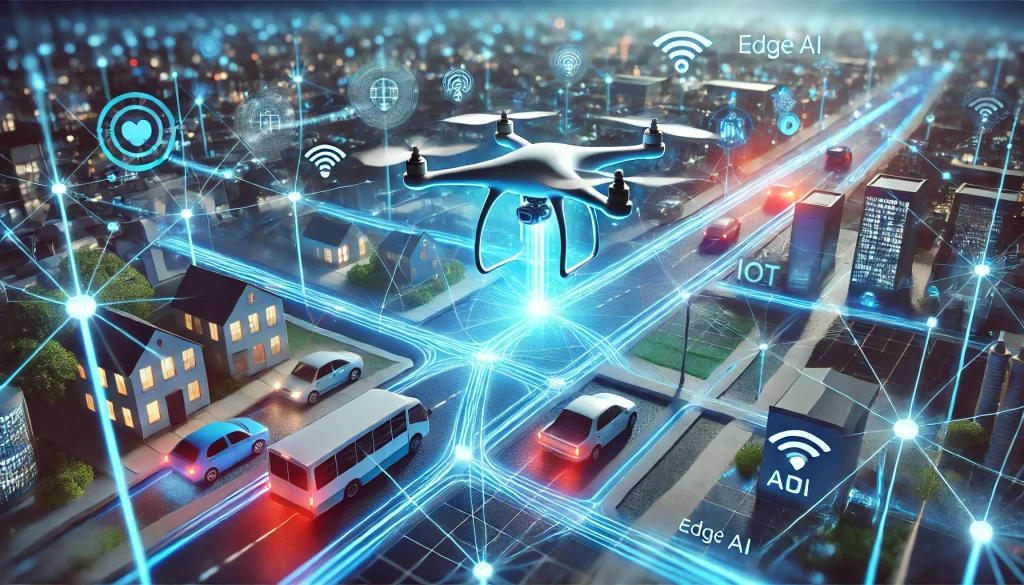Edge AI—The rapid advancements in artificial intelligence have given birth to a transformative paradigm, an innovation reshaping how real-time data is processed and utilized. Unlike traditional AI systems that rely heavily on cloud computing, it empowers devices to process data locally, significantly improving efficiency, security, and latency. This breakthrough has profound implications across industries, from autonomous vehicles to healthcare, making it a pivotal topic in technology today.

What Happened
Edge AI is taking center stage with significant developments over the past few months. Companies like NVIDIA, Intel, and Google have introduced cutting-edge edge AI solutions, driving the adoption of this technology. NVIDIA’s Jetson Orin platform, for instance, is designed to deliver unparalleled performance for autonomous machines. Meanwhile, Google has enhanced its Edge TPU ecosystem to optimize localized AI computing in IoT devices.
These announcements underscore the growing importance of edge computing in handling real-time, data-intensive tasks without reliance on centralized cloud systems. As the demand for faster, more secure data processing increases, the rise of it marks a pivotal shift in how industries approach intelligence and automation.
When and Where
The latest developments in it have unfolded globally, with announcements and product launches taking place throughout 2023. Key players such as NVIDIA unveiled their advancements at tech events like CES 2023, while Google showcased its Edge TPU updates during its Cloud Next conference. The rapid pace of innovation has made it a global phenomenon, with tech hubs in Silicon Valley, Europe, and Asia spearheading progress.
Who is Involved
The rise of it is driven by leading tech giants, startups, and research institutions. NVIDIA, Intel, Google, and Microsoft are leading the charge with their hardware and software innovations. Startups like Run:AI and BrainChip are also making waves by offering specialized solutions tailored for edge computing. Additionally, academic institutions are contributing cutting-edge research, ensuring the technology evolves rapidly.
Why It Matters
Its importance lies in its ability to process data locally, bringing significant advantages over traditional cloud-reliant AI systems.
1. Reduced Latency: Devices powered by it can analyze and act on data instantly, a critical requirement in applications like self-driving cars, robotics, and real-time medical diagnostics.
2. Enhanced Privacy: By processing data on local devices rather than transmitting it to a centralized cloud, it mitigates the risk of data breaches and enhances user privacy.
3. Scalability and Cost-Effectiveness: It reduces bandwidth and storage costs by minimizing data transfers, making it more economical for enterprises managing large-scale operations.
These benefits make it a game-changer across sectors like healthcare, manufacturing, retail, and energy, fueling innovation and efficiency.
Quotes or Statements
NVIDIA CEO Jensen Huang stated during CES 2023:
“Edge AI is the next frontier in computing. Our platforms enable machines to perceive, understand, and interact with their environments in real time, revolutionizing industries.”
Similarly, Sundar Pichai, CEO of Google, remarked:
“Localized AI processing ensures that our devices are smarter, faster, and more secure, ushering in a new era of intelligent connectivity.”
Conclusion
It is is redefining real-time data processing, enabling faster, more secure, and efficient AI applications. From empowering autonomous systems to enhancing IoT devices, its impact is profound and far-reaching. As innovations continue to unfold, the potential for it to transform industries remains immense. The next few years promise to bring even more groundbreaking advancements, cementing its role as a cornerstone of modern technology.
FAQ
What is Edge AI and how does it work?
It refers to artificial intelligence that processes data directly on local devices rather than relying on centralized cloud systems. This is achieved through advanced processors and specialized hardware like GPUs, enabling real-time decision-making without latency or data transfer delays.
How does Edge AI differ from traditional AI?
Traditional AI systems rely heavily on cloud computing, requiring data to be sent to centralized servers for processing. In contrast, Edge AI processes data locally on the device, offering faster response times, reduced bandwidth usage, and improved privacy.
What are the key applications of Edge AI?
It is used in autonomous vehicles, real-time video analytics, robotics, smart IoT devices, healthcare diagnostics, and industrial automation. Its ability to operate in real-time makes it indispensable in scenarios requiring instant decision-making.
Resources
NVIDIA Blog: Learn more about NVIDIA’s edge AI innovations.
Run Guide: Discover practical insights on Edge AI.
Red Hat Overview: Explore Edge AI’s role in edge computing.
DataCamp Blog: Understand Edge AI applications and trends.
Intel’s Edge AI Page: Learn about Intel’s Edge AI technologies.
